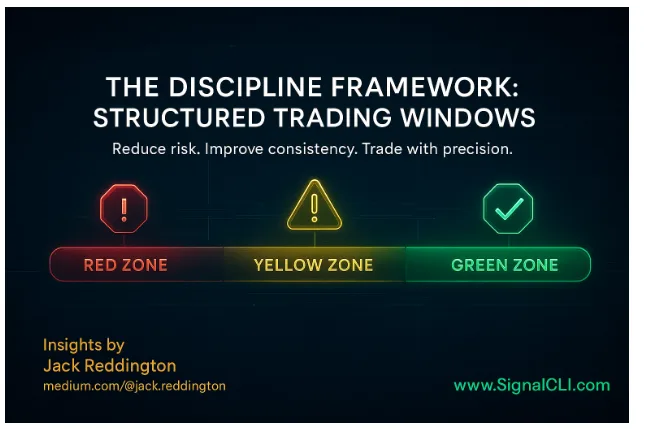The Discipline Framework: How Structured Trading Windows Reduce Risk and Improve Consistency in Crypto Futures

In crypto futures trading, profitability is only half the battle — the other half is surviving long enough to achieve it. In a market known for volatility and constant activity, traders face the temptation to enter positions at all hours, often reacting to emotion rather than evidence. For many, this results in inconsistent performance, increased risk, and unnecessary losses.
A growing number of professional traders are now turning to structured trading windows, a discipline-based approach that defines exactly when to engage with the market and when to stand aside.
What Are Structured Trading Windows?
Structured trading windows divide the trading day into three distinct categories:
- Green Zones – High-probability trading periods where liquidity, volatility, and directional bias align, creating the most favorable conditions for short-term positions.
- Yellow Zones – Moderate-probability periods that require stricter filtering and reduced exposure.
- Red Zones – Low-probability windows where market conditions are either too stagnant or too chaotic to justify entry.
This simple but powerful framework helps traders replace impulse with intention.
The Psychological Shift
For many traders, the biggest challenge is not finding entries — it’s avoiding the urge to overtrade. By committing to operate only during specific windows, decision fatigue is reduced, emotional pressure decreases, and focus improves. Traders stop “chasing the market” and start letting the market come to them.
In practice, a disciplined schedule means that a trader might only be active for certain blocks of time each day, ignoring all other hours completely.
Short-Term Trading Within the Framework
While structured windows can be applied to any style of trading, they are especially effective for short-term, high-precision sessions. In active Green Zones, it is not uncommon for skilled traders to execute 10–15 trades in a day — sometimes 25 or more — without stepping outside the boundaries of their schedule.
This high volume of opportunities is balanced by strict adherence to position sizing, leverage rules, and margin buffers. Trades are concentrated when conditions are optimal, but kept small enough that no single loss can harm the account’s long-term health.
Leaving Long-Term Trades Aside
Long-term positions that stretch over weeks or months operate under different risk models and objectives. Structured trading windows focus on short-term tactical opportunities — sessions where the goal is to identify multiple high-confluence setups, act decisively, and close positions within a tightly defined period.
By separating the two approaches, traders maintain clarity and avoid mixing incompatible strategies.
Risk Reduction Through Timing
One of the most overlooked aspects of risk management is timing. Even the strongest technical setup can fail if executed during poor market conditions. By concentrating activity within high-quality time windows, traders naturally reduce their exposure to unpredictable, low-liquidity environments.
This is especially valuable in leveraged crypto futures trading, where sudden price spikes or liquidity grabs can quickly erode profits or trigger liquidation for overexposed positions.
Data-Driven Schedules
Developing a reliable trading schedule requires significant data. It’s not enough to guess which hours might be best — patterns must be identified, tested, and validated over hundreds or even thousands of trades.
Providers or teams with high trading volume can build more accurate schedules by analyzing performance across different market sessions and conditions. This constant feedback loop allows schedules to evolve as markets change, keeping the framework relevant and effective.
Consistency as the Real Edge
In the long run, consistent execution beats occasional brilliance. Structured trading windows give traders a set of guardrails, ensuring that every decision — from entry timing to position size — fits within a proven plan. The result is a trading routine that is repeatable, measurable, and far less vulnerable to the psychological swings that often derail individual performance.
The Takeaway
Crypto futures trading offers opportunity at any hour of the day, but that doesn’t mean every hour offers opportunity worth taking. The discipline framework of structured trading windows is a powerful tool for reducing risk, improving consistency, and focusing effort where it matters most.
Whether a trader is looking to sharpen their short-term performance or simply bring more order to their daily routine, adopting a structured schedule is a decisive step toward lasting success in a market that rewards discipline as much as it does skill.
About SignalCLI
SignalCLI is a crypto futures signals provider focused on clarity, precision, and informed decision-making. Using a combination of established technical indicators, Smart Money Concepts, and advanced AI analysis, SignalCLI delivers structured, data-driven insights to help traders identify high-probability setups in fast-moving markets. The service is designed for those who value disciplined execution, risk awareness, and timing over speculation. For deeper insights and practical examples, visit www.signalcli.com and explore Jack Reddington’s Medium for trading strategies, market breakdowns, and educational articles.
